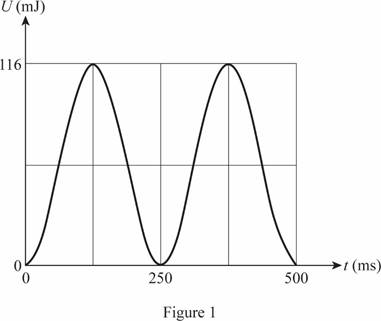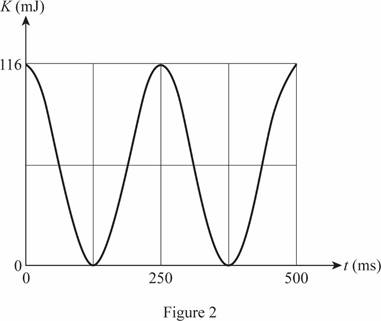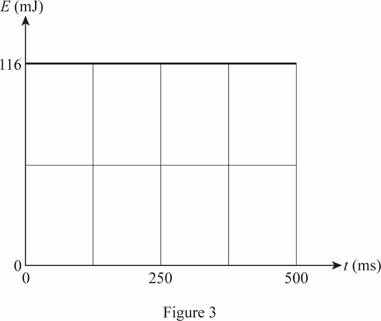
Concept explainers
(a)
A plot of the elastic potential energy versus time.
(a)
Answer to Problem 61P
The elastic potential energy is a sinusoidal curve with amplitude
Explanation of Solution
The mass of the object is
Write the expression for elastic potential energy
Here,
Write the given expression for position as a function of time.
Here,
Substitute (II) in (I)
Write the expression for spring constant
Here,
Write the expression for angular frequency
Here,
Substitute
Substitute
Substitute
The time period of the square of a sine curve is half of the time period of the sine curve.
Write the expression for time period of the potential energy
Here,
Substitute
Use the above obtained expression for

(b)
A plot of the kinetic energy versus time.
(b)
Answer to Problem 61P
The kinetic energy curve is a cosine curve with amplitude
Explanation of Solution
Write the expression for kinetic energy
Here,
Differentiate (I) to find
Square (VIII) and substitute in (VII)
Substitute
The time period of the square of a cosine curve is half of the time period of the cosine curve.
Write the expression for time period of the potential energy
Here,
Equation (VI) and (X) are the same and hence
Use the above obtained expression for

(c)
A plot of the total energy versus time.
(c)
Answer to Problem 61P
The total energy curve is a straight line parallel to the time-axis with a y-intercept of
Explanation of Solution
Write the expression for total energy
Here,
Substitute the obtained expression of
Thus, energy is constant and hence it is a straight line parallel to the time axis. (Refer figure 3)

(d)
The effect of a friction on the above results.
(d)
Answer to Problem 61P
All three energies of the spring approaches zero.
Explanation of Solution
When the frictional forces are included, the system is no more conservative and it is called a non-conservative system. The energy of the system is not conserved.
If the horizontal surface is not considered as frictionless, then the surface resists the oscillatory motion of the spring and thereby reducing its kinetic energy. A part of the kinetic energy is lost in the form of heat and consequently the all three energy of the system reduces to zero.
Want to see more full solutions like this?
Chapter 10 Solutions
Physics
- Rod AB is fixed to a smooth collar D, which slides freely along the vertical guide shown in (Figure 1). Point C is located just to the left of the concentrated load P = 70 lb. Suppose that w= 17 lb/ft. Follow the sign convention. Part A Figure 3 ft -1.5 ft √30° 1 of 1 Determine the normal force at point C. Express your answer in pounds to three significant figures. ΜΕ ΑΣΦ Η vec Nc= Submit Request Answer Part B Determine the shear force at point C. Express your answer in pounds to three significant figures. VC= ΜΕ ΑΣΦΗ vec Submit Request Answer Part C Determine the moment at point C. Express your answer in pound-feet to three significant figures. Mc= Ο ΑΣΦ Η vec Submit Request Answer Provide Feedback ? ? lb lb ? lb-ftarrow_forwardConsider a uniformly charged ring of radius R with total charge Q, centered at the origin inthe xy-plane. Find the electric field (as a vector) at a point on the z-axis at a distance z above thecenter of the ring. Assume the charge density is constant along the ring.arrow_forward3) If the slider block C is moving at 3m/s, determine the angular velocity of BC and the crank AB at the instant shown. (Use equation Vs Vc wx fuc, then use equation Vs VA + Ve/athen write it in terms of w and the appropriate r equate the two and solve) 0.5 m B 1 m 60° A 45° vc = 3 m/sarrow_forward
- 3) If the slider block C is moving at 3m/s, determine the angular velocity of BC and the crank AB at the instant shown. (Use equation Vs Vc wxf, then use equation V, VA + Va/Athen write it in terms of w and the appropriate r equate the two and solve) f-3marrow_forwardPls help ASAParrow_forwardPls help ASAParrow_forward
- 14. A boy is out walking his dog. From his house, he walks 30 m North, then 23 m East, then 120 cm South, then 95 m West, and finally 10 m East. Draw a diagram showing the path that the boy walked, his total displacement, and then determine the magnitude and direction of his total displacement.arrow_forwardPls help ASAParrow_forwardPls help ASAParrow_forward
- Pls help ASAParrow_forwardPls help ASAParrow_forward12. A motorboat traveling 6 m/s, West encounters a water current travelling 3.5 m/s, South. a) Draw a vector diagram showing the resultant velocity, then determine the resultant velocity of the motorboat. b) If the width of the river is 112 m wide, then how much time does it take for the boat to travel shore to shore? c) What distance downstream does the boat reach the opposite shore?arrow_forward
 College PhysicsPhysicsISBN:9781305952300Author:Raymond A. Serway, Chris VuillePublisher:Cengage Learning
College PhysicsPhysicsISBN:9781305952300Author:Raymond A. Serway, Chris VuillePublisher:Cengage Learning University Physics (14th Edition)PhysicsISBN:9780133969290Author:Hugh D. Young, Roger A. FreedmanPublisher:PEARSON
University Physics (14th Edition)PhysicsISBN:9780133969290Author:Hugh D. Young, Roger A. FreedmanPublisher:PEARSON Introduction To Quantum MechanicsPhysicsISBN:9781107189638Author:Griffiths, David J., Schroeter, Darrell F.Publisher:Cambridge University Press
Introduction To Quantum MechanicsPhysicsISBN:9781107189638Author:Griffiths, David J., Schroeter, Darrell F.Publisher:Cambridge University Press Physics for Scientists and EngineersPhysicsISBN:9781337553278Author:Raymond A. Serway, John W. JewettPublisher:Cengage Learning
Physics for Scientists and EngineersPhysicsISBN:9781337553278Author:Raymond A. Serway, John W. JewettPublisher:Cengage Learning Lecture- Tutorials for Introductory AstronomyPhysicsISBN:9780321820464Author:Edward E. Prather, Tim P. Slater, Jeff P. Adams, Gina BrissendenPublisher:Addison-Wesley
Lecture- Tutorials for Introductory AstronomyPhysicsISBN:9780321820464Author:Edward E. Prather, Tim P. Slater, Jeff P. Adams, Gina BrissendenPublisher:Addison-Wesley College Physics: A Strategic Approach (4th Editio...PhysicsISBN:9780134609034Author:Randall D. Knight (Professor Emeritus), Brian Jones, Stuart FieldPublisher:PEARSON
College Physics: A Strategic Approach (4th Editio...PhysicsISBN:9780134609034Author:Randall D. Knight (Professor Emeritus), Brian Jones, Stuart FieldPublisher:PEARSON





